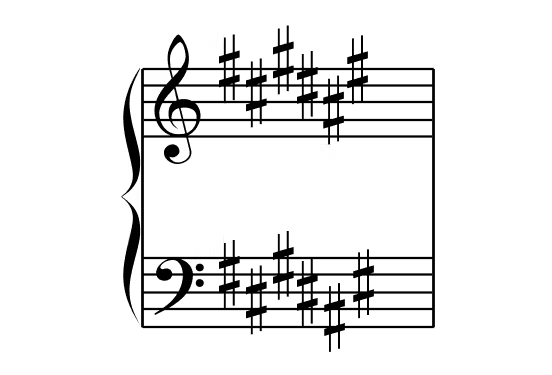The F-sharp Major Scale on the Piano - Scales, Chords & Exercises
Jump to section
You get a fascinating chord poster + exclusive content!

What Are the Notes and Pitches of the F-sharp Major Scale?
The F-sharp Major scale starts on F-sharp and includes a whopping six sharps! It is the enharmonic twin of G-flat Major with six flats - this means it sounds just the same on the piano. The pitches/notes used are F#-G#-A#-B-C#-D#-E#-F#. On the piano, you need to play all black keys, the white key of B, and the E# (which is the F piano key under other circumstances).

How to Play the F-sharp Major Scale With the Right Hand (Treble Clef)
On the piano, you can pay any scale going up (toward the higher notes), or coming down.
- Play the following notes going up in the treble clef: F#-G#-A#-B-C#-D#-E#-F#. Start playing with your second finger on the F#, and continue with the G# and the third finger as well as the A# and the fourth finger. Then tuck your thumb under to reach the B, play the C# and D# with the second and third finger, and tuck the thumb once more to play the E# (F key). Use the second finger to play the F#.
- Play the following notes going down: F#-E#-D#-C#-B-A#-G#-F#. Go down inversing the exact way you have played coming up: Start playing with your second finger. After the thumb has played the E#, tuck your third finger over the thumb to play the D#, and continue until your first finger reaches the B, then tuck your fourth finger over to play the A# and continue down to F#, which you play with your second finger.

How to Play F-sharp Major With the Left Hand (Bass Clef)
Piano beginners may find it difficult to read and play the left hand. It is worth investing some time to really familiarize yourself with the notes of the F-sharp Major scale in the bass clef, and learn how to read them in music scores.
The notes are the same as in the right hand (F#-G#-A#-B-C#-D#-E#-F#), but they look different in the different clefs:

How to Play:
- Going up: Starting with your fourth finger on F#, use the third finger for the G# and the second finger for the A#. This allows you to play the B with your first finger. Then tuck your third finger over to play the C#. Play the D# with your second finger and the E# (the F key) with your first finger, and the final F#, with a tuck, and your second finger.
- Coming down: Reverse exactly what you have done on your way up. Start with your second finger on F#, then play the E# with your first finger. Tuck and play the D# with your second finger and the C# with your third. Then tuck again to play the B with your first finger, and play down to F#, which you'll reach with your fourth finger.
The F-sharp Major Key Signature
The key signature, located at the beginning of each line of a piece, lets you see which notes will be raised (#) or lowered (b) consistently throughout that piece. If you spot a key signature looking like this, it is very likely that the piece is in F-sharp Major (or the parallel minor scale, D-sharp minor, you can determine that by listening to the "mood" of the piece):

6 Exercises to Practice the F-sharp Major Scale
Play one exercise after the other and only move on after having correctly played the previous exercise 5 times on your piano:
- Play the left hand up and down using a metronome and slowly increasing speed
- Play the right hand up and down using a metronome and slowly increasing speed
- Play both hands up and down using a metronome and slowly increasing speed
- Play the left hand up starting from the lowest F# to the highest, and down starting from the highest F# to the lowest
- Play the right hand up starting from the lowest F# to the highest, and down starting from the highest F# to the lowest
- Play both hands up starting with the left hand on the lowest F# and stopping when the right hand reaches the highest F#, then play down to the starting position.
Why you should exercise scales in general
- To memorize a scale
- To practice dexterity and intonation (play all keys with even loudness. Beginners often play the notes they work with their stronger fingers much harder. Aim for an even tone)
- To be able to play the scale in time without hesitating to find your fingerings
- To be able to build chords and improvise
The F-sharp Major Chord
A major chord is constructed of three or more notes: The root note - the major third - the perfect fifth.
Briefly explained, this tells us for F-sharp Major:
- The basic F-sharp Major chord consists of F#-A#-C#.
- The first inversion is A#-C#-F#.
- The second inversion is C#-F#-A#.
To practice the F-sharp Major chord and its inversions, switch from the chord starting with the root note to the first, and the second inversion, starting slowly using a metronome, then increase your tempo.
Top pieces in F-sharp Major
- 1 Va, pensiero (Chorus Of The Hebrew Slaves): Giuseppe Verdi
- 2 You'll Be In My Heart: Phil Collins
- 3 Luka: Suzanne Vega
- 4 Heaven Knows I'm Miserable Now: The Smiths
- 5 Firestarter: The Prodigy
- 6 Eyes Closed And Traveling: Peter Broderick
- 7 Piano Piece F-sharp Major, S 192 No. 3: Franz Liszt
- 8 Swanee River: Anonymous
- 9 The Most Beautiful Girl In The World: Prince
- 10 Prelude 13 F-sharp Major, BWV 858: Johann Sebastian Bach


